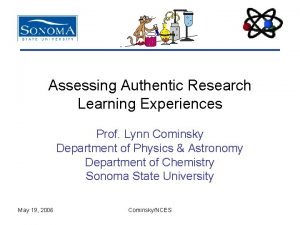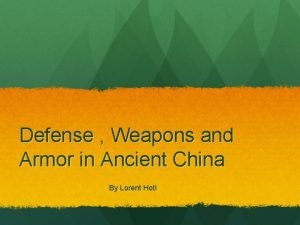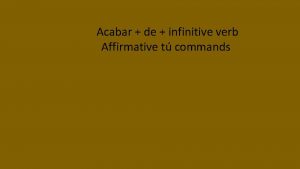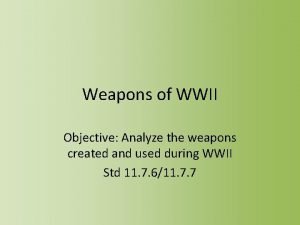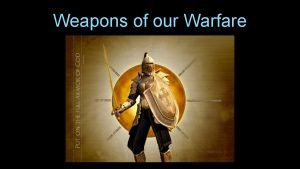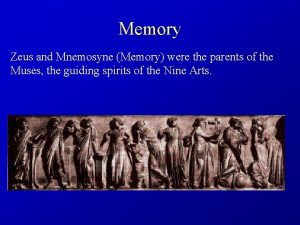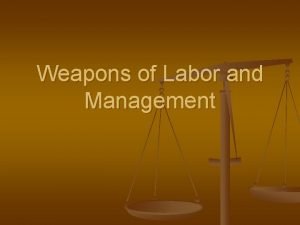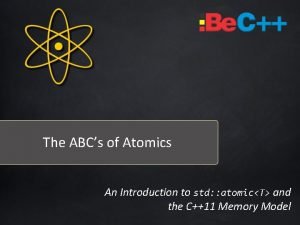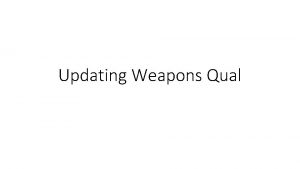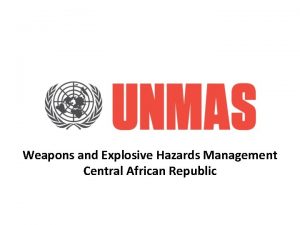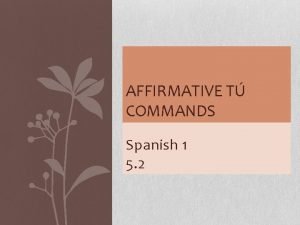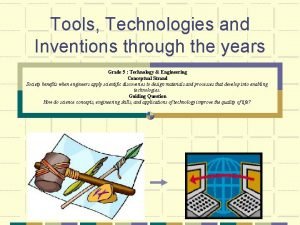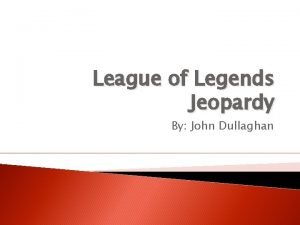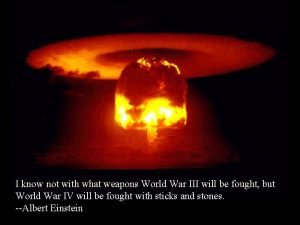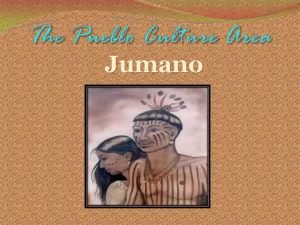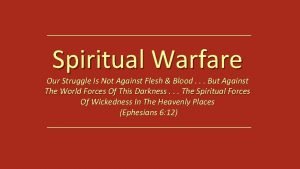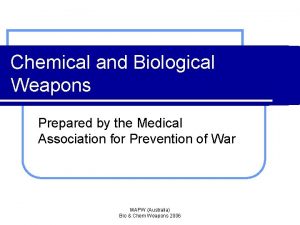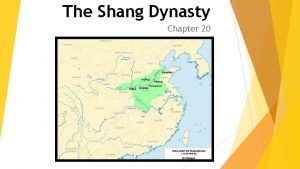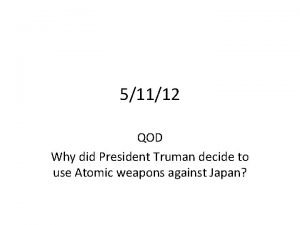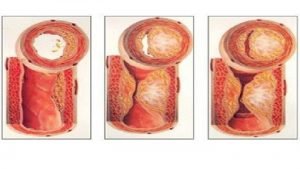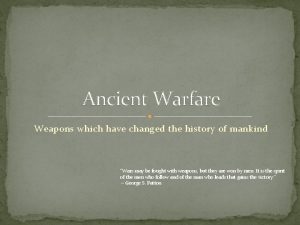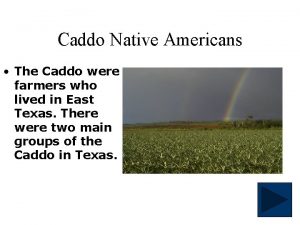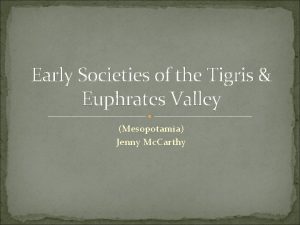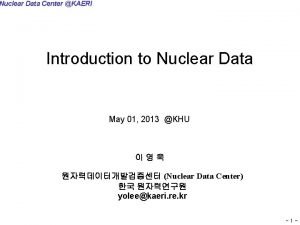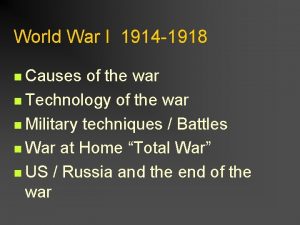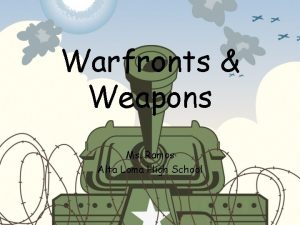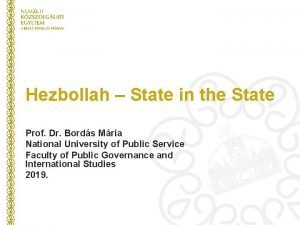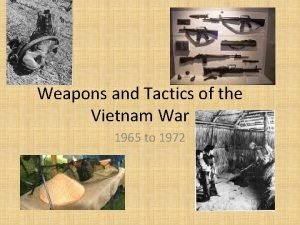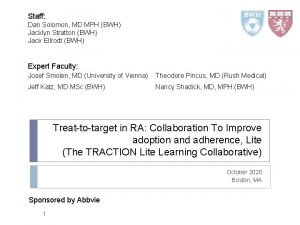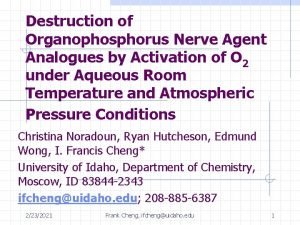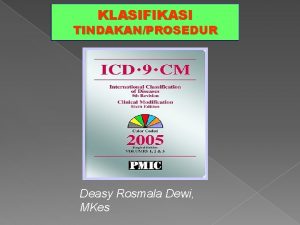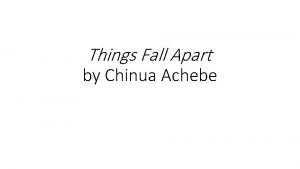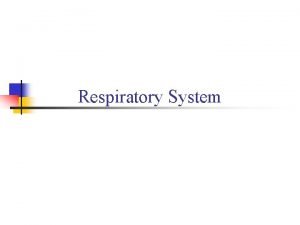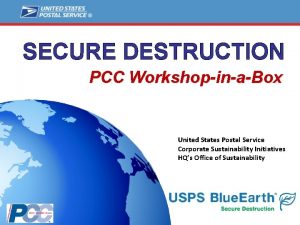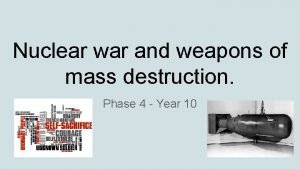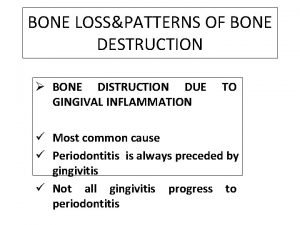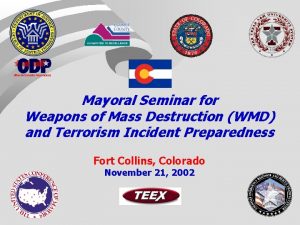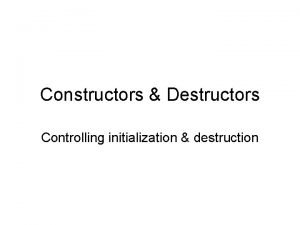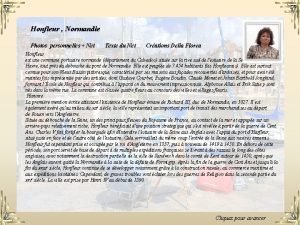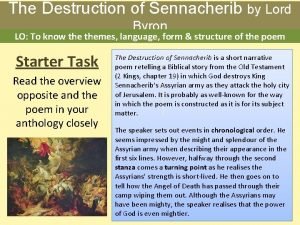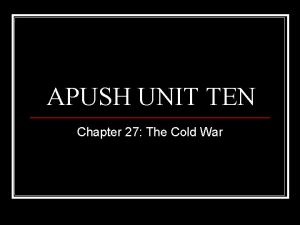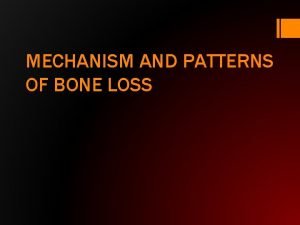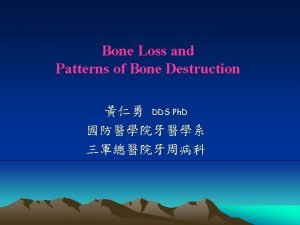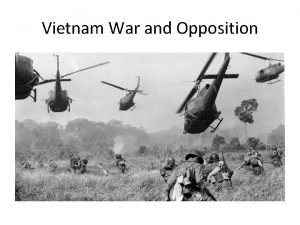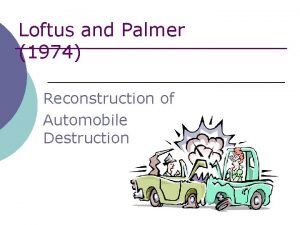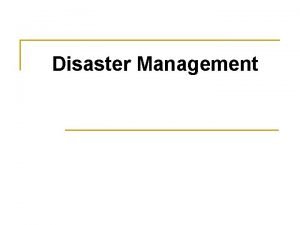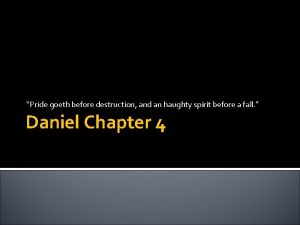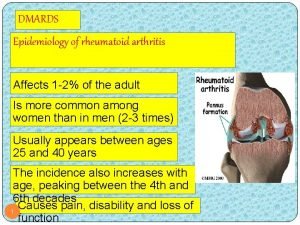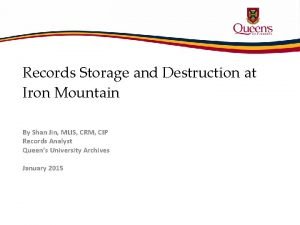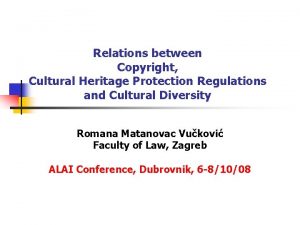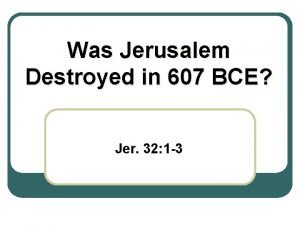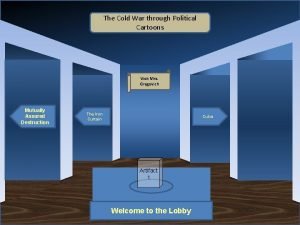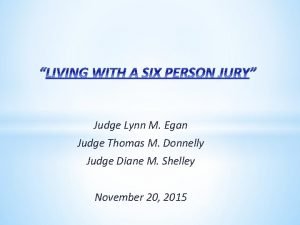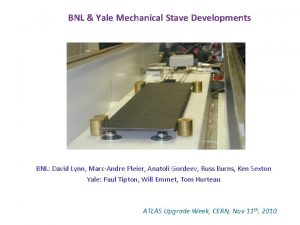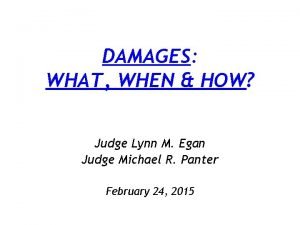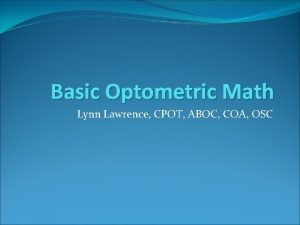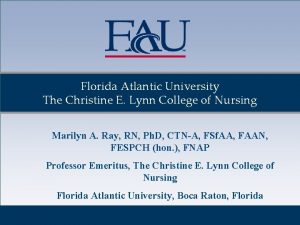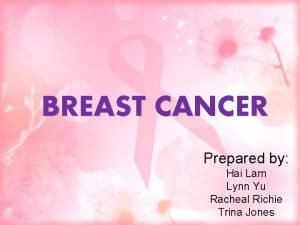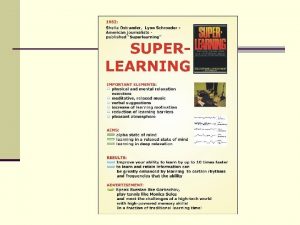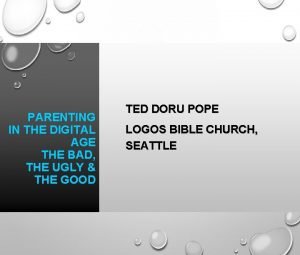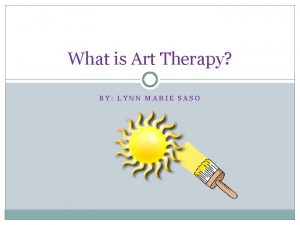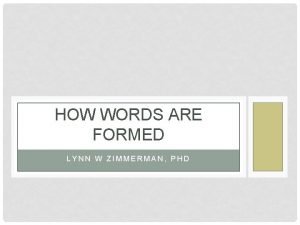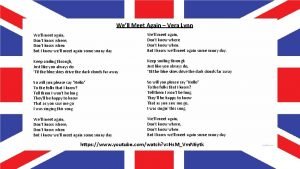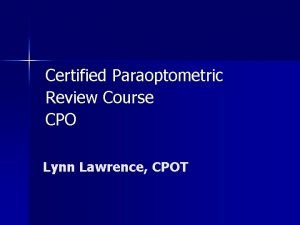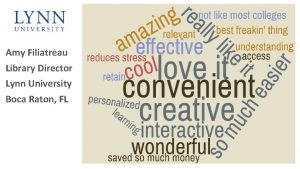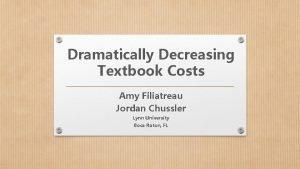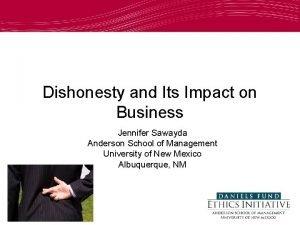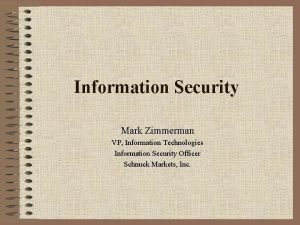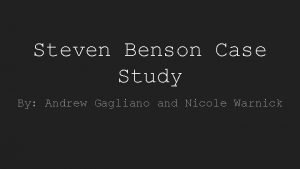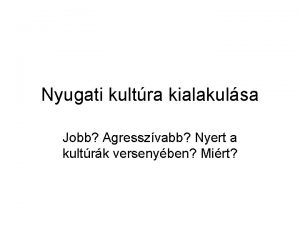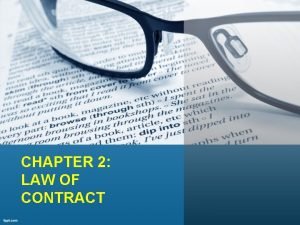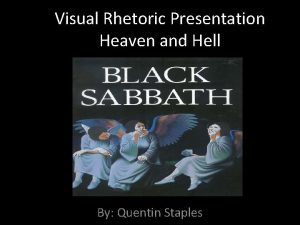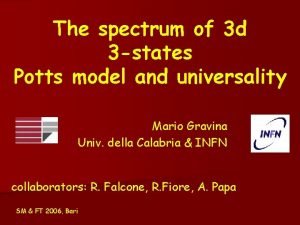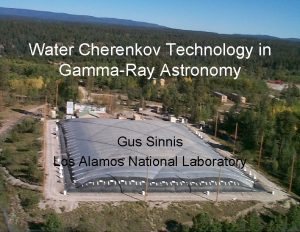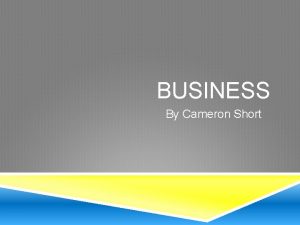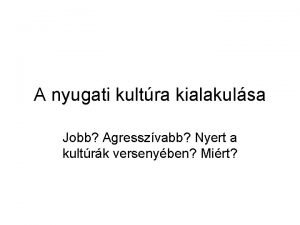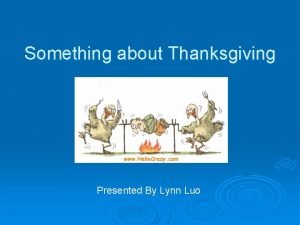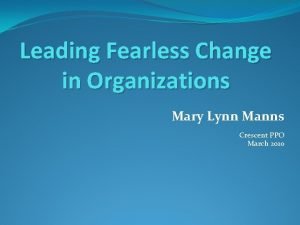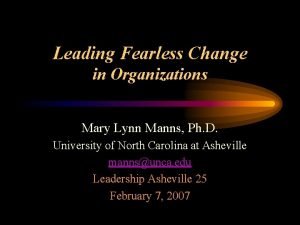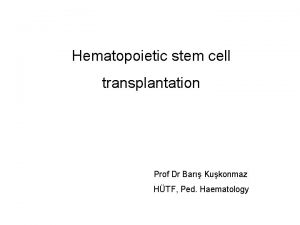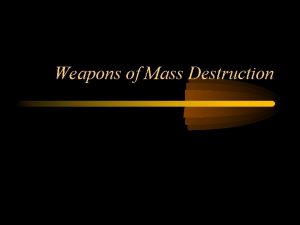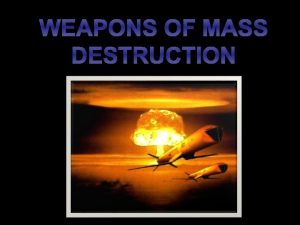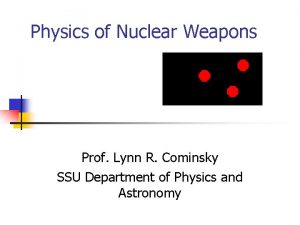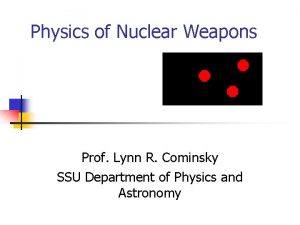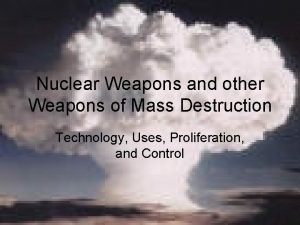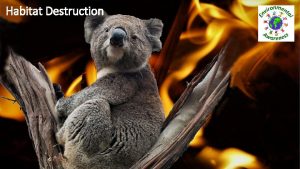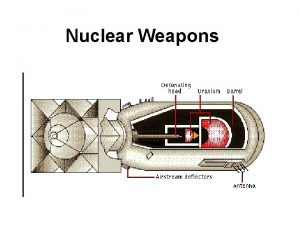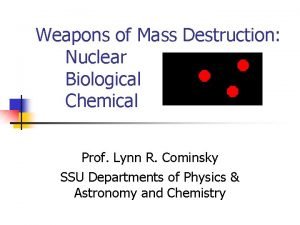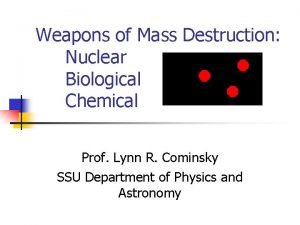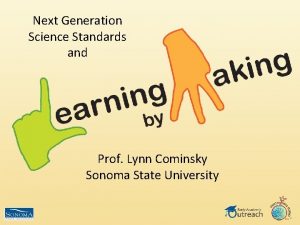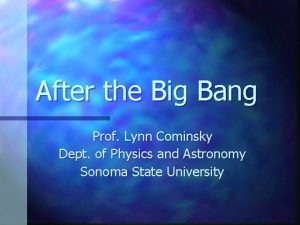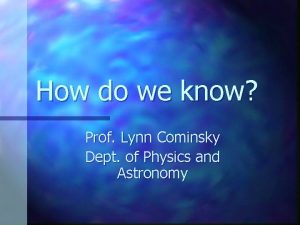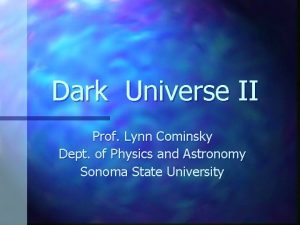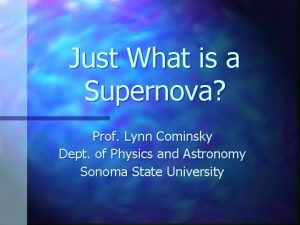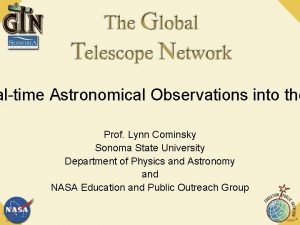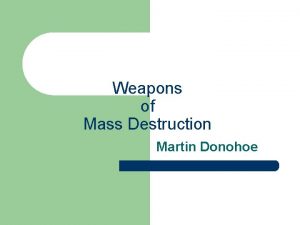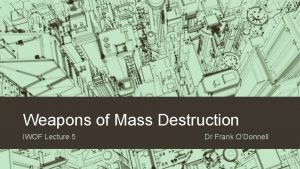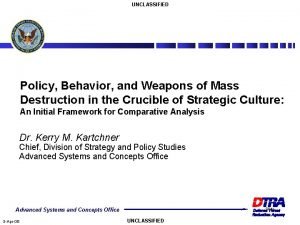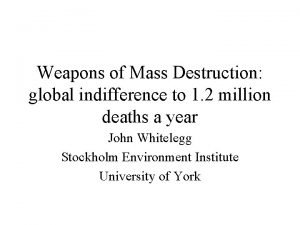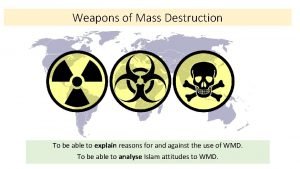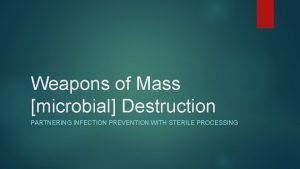Weapons of Mass Destruction Prof Lynn R Cominsky






































































































- Slides: 102

Weapons of Mass Destruction Prof. Lynn R. Cominsky Department of Physics & Astronomy

Talk Outline n n n What kills people in wars? What are Weapons of Mass Destruction? Chemical Weapons n n n Sarin Syria Update Nuclear Weapons n n n Fission Fusion Effects Proliferation Some hopeful signs

Major killers in Wars n n n Howitzer Assault Rifles (64%) Handguns (10%) Landmines (10%) Hand grenades, Artillery, Mortars (16%) Since 1900: 34 million soldiers and 80 million civilians killed in wars world-wide M 16

What are WMDs? n n n More powerful than a speeding bullet… Able to destroy great masses of humanity, including civilians with a single blow…. Rarely used but capable of inducing terror when used… n n n Nuclear – A-bombs and H-bombs Chemical – Sarin (nerve gas) and others Biological – Anthrax, Ebola and others

History of Sarin n n Invented by the Nazis in 1938, it went into production at the end of WWII It was NOT the gas used in the gas chambers – that was Zyklon B, a cyanidebased pesticide Sarin was produced and stockpiled by US and USSR beginning in 1950 Following the ratification of the Chemical Weapons Convention (treaty), the stockpiles began to be destroyed

Chemical Weapons Convention n n First disarmament treaty to include a time frame for the elimination of an entire class of weapons of mass destruction First multilateral arms control treaty to incorporate an intrusive verification regime In force since 4/29/97 http: //www. cwc. gov/ http: //www. opcw. org/

Use of Sarin in recent times n n Japanese sect used Sarin in 1994 and 1995, killing 8 + 13 people Iraq/Hussein used Sarin on the Kurds in 1987 -8 and also on Iranian soldiers n n Attack on Halabjah in March 1988 killed ~4000 Kurds, injured ~10, 000 Sarin gas has killed ~1400 people near Damascus – videos and images are online – did Assad gas his own people?

Death toll in Syria (2013) n Estimated at between 80, 000 and 100, 000 to date since the civil war started in spring 2011 – half civilians

So why is Sarin so bad? n n Conventional weapons have killed ~100 times more people than Sarin in the Syrian civil war Chemical weapons are banned by treaty signed/ratified by all but: n n n Israel Myanmar Syria N. Korea South Sudan Egypt Angola It is therefore a “banned” substance

But mostly - Sarin is Scary! n n Colorless, odorless liquid that can be easily aerosolized for distribution Nerve agent that causes paralysis of muscles, leading to asphyxiation when lung muscles cannot function Lethal dose is 0. 5 mg for adult human Sarin is relatively easy to manufacture – it does not need sophisticated technology

Getting rid of Sarin n n Can’t bomb factories or storage depots – that would spread toxic materials Hard to track because easily concealed and moved around Need verifiable process to monitor the stockpile and oversee destruction or removal of materials However, it is difficult to prevent new manufacturing unless factories are also monitored

Nuclear weapons – some history n n World War II coincided with advances by physicists in understanding the inner workings of the atom These physicists understood that it was possible to release huge amounts of energy by breaking apart or smashing together nuclei of atoms – far more than can be released in chemical reactions, which rely on electrons

WWED? n n n By 1939 many prominent (mostly Jewish) physicists had fled Europe and resettled in the USA Albert Einstein signed a letter to President Roosevelt alerting him to the terrible potential of weaponizing nuclear reactions But until Pearl Harbor in 1941, the USA did not invest much in this research

Manhattan Project n n After 1941, the US began to race Nazi Germany to develop nuclear weapons Manhattan Project was really located in Los Alamos, NM Most of the funding went to build factories that could produce the materials needed to make the bombs The first successful test was Trinity on 7/16/45 in Alamogordo, NM

Why is an atomic bomb so much worse than a TNT bomb? n n n Amount of heat and light energy released is 1000 times greater Explosion is accompanied by invisible, penetrating and harmful radiation After explosion, radioactive fallout remains and continues to damage living things for days Ground level view weeks years of Hiroshima cloud

Physical Effects of Nuclear Weapons n Thermal n n n Trinity Fireball Firestorms Mushroom Cloud Initial (prompt) Radiation n n Alpha particles (4 He++) Beta particles (e+ and e-) Gamma-rays (g) Neutrons (n) Bridge in Hiroshima

Physical Effects of Nuclear Weapons Hiroshima buildings n Pressure Blast Wave n n Buildings collapse Fallout n n Radioactive fragments which stick to air particles or dirt that is sucked up mushroom stem 80% falls back down in first day 90% falls back down in first week 10% lasts weeks years Google Nuclear Weapon Effects Calculator to try it out on your city! Nagasaki victim

Physical Effects of Nuclear Weapons n Electromagnetic Pulse n n n Strongest for very high bursts g-rays ionize air electrons Electrons create large currents in air Currents are picked up by power lines Power surges shut down grid, destroy attached electrical devices 1. 4 Mton airburst in 1962 knocked out lights in Hawaii over 1000 miles away

Electromagnetic Pulse Effects http: //www. fas. org/nuke/intro/nuke/emp. htm

Nuclear Weapons are Scary too! n n n Most of the lasting effects are due to radiation, so are odorless and colorless Genetic damage and cancers can take 20 or more years to develop A single bomb can kill 100, 000 people and destroy an entire city It does not take much nuclear material to create a big explosion However, it does take considerable engineering to make a bomb that works

Nuclear physics vs. Chemistry e n p n n p 4 He e Helium Atom: 2 electrons (e) 2 protons (p) 2 neutrons (n) n Chemistry: change the number of electrons typical energies involved are a few electron Volts (e. V) Nuclear physics: change the number of protons or neutrons in the nucleus typical energies involved are millions of e. V (Me. V)

Fission Weapons n Fission n releases energy in elements heavier than Iron Bombard U or Pu with neutrons, they split into fragments, releasing energy “A” bombs n n 235 U n n

Critical mass chain reactions n n n When a large enough mass of either 235 U or 239 Pu is assembled, a self-sustaining chain reaction results after the first fission is produced. The minimum (“critical”) mass of fissile material that can sustain a nuclear chain reaction depends on the density, shape, and type of fissile material, as well as the effectiveness of any surrounding material (called a reflector or tamper) at reflecting neutrons back into the fissioning mass. Depleted U is often used in the tamper

The first “A” bombs n Trinity – Gadget (7/16/45) n n n Little Boy (8/6/45) n n n Alamagordo test range in New Mexico 20 k. Ton yield Hiroshima 15 k. Ton yield Fat Man (8/9/45) n n Nagasaki 20 k. Ton yield Museum display in NM

How to make an “A” bomb n n Use >90% 235 U Squeeze and confine evenly Reflect neutrons back into 235 U Use initial explosive device to trigger Little Boy (Hiroshima 8/6/45) 3 m A-bomb dome http: //www. pcf. city. hiroshima. jp/peacesite/English/Stage 1/1 -3 -3 E. html

“Fat Man” style of A-bomb n High explosives are arranged to form an imploding shock wave which compresses the fissile material to supercriticality. § Burst of neutrons from generator is timed for moment of maximum compression

Fusion Weapons n Fusion n n D D Elements lighter than Iron release energy when combined Deuterium, Tritium, Lithium Reactions that occur inside Sun “H” bombs Thermonuclear Reactions n Heat from reaction increases reaction rate, so less fuel is needed “efficient” bomb 4 He

The “secret” of the H-bomb n n At the high temperatures of a fission bomb 80% or more of the energy exists as soft X-rays The X-rays heat a polystyrene channel, causing plasma which can compress and ignite the second (fusion) stage before the expanding (1000 km/sec) primary disrupts it.

How big are the weapons? n n n 1 k. Ton = 1000 tons = 2, 000 pounds of TNT equivalent ~2 pounds of 235 U 20 k. Tons Today’s warhead is 100 -200 k. Tons Largest underground burst: 4. 5 Mtons Largest airburst: 58 Mtons Over 1700 known tests since 1945

Who has nuclear weapons? Thermonuclear Fission Israel(80) Russia (4500) UK (150) N. Korea (<15) US (2700) China(180) # Warheads France (300) http: //www. ucsusa. org/assets/documents/nwgs/Wordwide. Nuclear-Arsenals-Fact-Sheet. pdf India(50) Pakistan(60)

Nuclear Non-Proliferation Treaty n n Vertical – development of new weapons by the “Big 5” Horizontal – spread of weapons to other countries “Haves” agree not to spread weapons, materials or technology to “have-nots” – also, to stop vertical proliferation “Have-nots” agree not to try to acquire weapons from the “haves, ” and will accept inspection and regulation of “peaceful” nuclear technology by IAEA- this stops horizontal proliferation

Nuclear Non-Proliferation Treaty n n n NPT indefinitely extended since May 1995, confirmed again in 2000, reviewed most recently in May 2010 Now signed by 189 countries N. Korea ratified in 1985 then withdrew in 2003. In 2006 and 2009, it conducted nuclear tests. Israel, India and Pakistan are still not signatories. Iran remains a signatory but is in violation according to 2011 IAEA report which is disputed. This report describes in depth, the country’s detonator development, the multiple-point initiation of high explosives, and experiments involving nuclear payload integration into a missile delivery vehicle.

July 2008 Non-proliferation Treaty Map http: //en. wikipedia. org/wiki/Image: NPT_Participation. svg n n n Signed and ratified Acceded or succeeded Unrecognized state but abiding by treaty Withdrawn Non-signatory

Some hopeful signs n New START (STrategic Arms Reduction Treaty) signed April 8, 2010 by Obama and Medvedev – and then ratified by Senate and put into force on Feb. 5, 2011 n n Limits deployed strategic nuclear warheads to 1, 550 Limits deployed and non-deployed ICBM, SLBM, and heavy bombers to 800. Limits deployed ICBMs, deployed SLBMs, and deployed heavy bombers to 700 For the first time in a long time, US and Russia are slowing vertical proliferation

Some hopeful signs n 2012 Nuclear Security Summit in Seoul, South Korea (3/26 -27/12) n n Set a target date of 2014 for bringing the amendment of the Convention for the Physical Protection of Nuclear Materials (CPPNM) into force; Several nations (incl. Italy) pledged to eliminate their stocks of fissile material; Agreement between the U. S. , France, Belgium and the Netherlands to produce medical isotopes without the use of highly enriched uranium by 2015. Next summit in 2014 in the Netherlands

Additional Resources n Carnegie Endowment for International Peace n Biological and Chemical Weapons Resources http: //www. ceip. org/ http: //www. fas. org/main/content. jsp? form. Action=325&project. Id=4 n US position on BTWC (2001) n CDC Vector Borne Diseases n n http: //www. fas. org/bwc/news/USPublic. Positions. On. Protocol. htm http: //www. cdc. gov/ncidod/dvbid/index. htm Chemical Weapons Convention http: //www. cwc. gov/ Federation of American Scientists http: //www. fas. org Iran Watch (Wisconsin Project) http: //www. iranwatch. org/ Union of Concerned Scientists http: //ucsusa. org


Biological and Chemical slides

Types of Biological Weapons n Bacteria n n Cause disease by reproducing Single cell organism Typhus, anthrax Viruses n n n Anthrax Multiply only inside host cells Sub-microscopic organisms Ebola, Chikungunya Ebola

Types of Biological Weapons n Rickettsia n n n Larger than viruses Smaller than bacteria From fleas, lice and ticks Q-fever Toxins n n Poisons from living things Snake venom Botulinum most lethal known – <10 -6 g! But some beneficial uses

Types of Chemical Weapons n Nerve agents n n n Mustard agents n n n Inhibit enzyme that transmits messages from nerve cells to muscles Lethal dose <1 -10 mg Blistering of skin, lungs Lethal dose >500 mg Hydrogen Cyanide (HCN) gas n n Prevents blood from carrying oxygen Lethal dose > 120 mg

Types of Chemical Weapons n Tear gases n n Arsines n n Cause pain in eyes Do not affect horses or dogs Short term effects Mixed with mustard gas Psychotomimetic agents n n Cause temporary psychosis LSD, atropine LSD

Why Use Chemical or Biological Weapons? n n n Cheap Easy Technology Simple delivery systems n n Artillery shells Rocket launchers Aerosol sprays Research into biological weapons continues for treating diseases, developing vaccines, anti-toxins, etc.

Chemical/Biological Weapons Problems n n Chemical weapons largely ineffective Biological weapons can’t be stored Protection against both is relatively easy on the battlefield Both are really “weapons of terror” against citizens or “weapons of intimidation” against soldiers rather than “weapons of mass destruction”

Biological/Chemical Terrorism n n n Since 1900, only ~75 terrorist attacks out of more than 40, 000 used Chemical or Biological weapons Only 125 people died & ~4000 got sick ~20 people died in Japan in the wellpublicized nerve gas attacks. This sect also tried to make biological weapons but failed, after spending $1 billion.

Backup Slides

The Helium Atom e p n n p • 2 protons = Z = atomic number 2 neutrons = N • e 4 He Two electrons orbiting a nucleus with: • • Total mass = A = Z+N Singly ionized Helium is missing one electron = 4 He+ Doubly ionized Helium is missing both electrons = a particle = 4 He++

Isotopes and Elements e n p n n If Helium loses one of its protons, it becomes a different element 3 H e e n If Helium loses one of its neutrons, it becomes an isotope 3 He p n p e

Materials n Tritium = 3 H = very heavy Hydrogen (1 p + 2 n), used in fusion weapons n Deuterium = 2 H = heavy Hydrogen (1 p + 1 n), used in fusion weapons n Uranium: 238 U is >99% in nature 235 U is ~0. 7% in nature – major ingredient in fission weapons n Plutonium: 239 Pu is not found in nature, used in fission weapons

Uranium processing n n Uranium is mined as ore from open pits or deep shaft mines, often with the help of extracting solutions At nearby mills, ore is crushed and U is extracted, leaving behind radioactive tailings Extracted U is then leached (with sulfuric acid) forming a concentrate known as “yellowcake” (aka Uranium oxide U 3 O 8) Yellowcake is then turned into UF 6 gas, which can be cooled to a solid for easier transport

Uranium in power plants n n n The “yellowcake” is turned into pellets which are packed into 12’ fuel rods Bundles of fuel rods are placed at the cores of nuclear reactors The US has ~ 100 nuclear reactors: 2/3 of these are “pressurized” water reactors; 1/3 are “boiling” water reactors. Both heat water to cool the rods and create electricity.

Enriching Uranium n n Naturally occurring Uranium must be enriched to >90% 235 U in order to make fission weapons (or to ~5% for nuclear power plants) Enrichment methods n n n Gas centrifuge (now being used in Iran and found in Iraq after 1 st Gulf War) Gaseous diffusion (used in USA) Electromagnetic isotope separation – (unexpectedly found in Iraq after 1 st Gulf War)

Yongbyon nuclear facility n Read more at: http: //www. iht. com/articles/2008/09/25/asia/25 korea. php n http: //www. pbs. org/newshour/indepth_coverage/asia/northkorea/nuclear. html Blowing up cooling tower in June 2008

Iran’s Nuclear Summit n n n Following the “New START” and DC Nuclear Summit, Iran held a summit (4/17 -18/10) “Nuclear Energy for All, Nuclear Weapons for No One” Eliminate all nuclear weapons but allow countries to develop nuclear power Iran considers itself a “nuclear state” and claims all its enrichment activities are for peaceful purposes. Iran insists the US pressure Israel to sign NPT

Gas centrifuge n n Uses successive stages to isolate isotopes by weight – lighter mixture is sent on to the next stage, heavier mixture is sent back to the previous stage Requires thousands of successive stages to create weapons grade 235 U

Enriching Uranium in Iran n As of 2003, Iran was developing an extensive, underground enrichment facility for Uranium Most of the centrifuges are underground, in order to withstand aerial attack – only 1 -2% would be needed to make sufficient quantities of highly enriched U for a weapons program Iran’s stated goal for this facility is production of sufficient low-enriched U to generate 6000 MW electricity through power plants

2003 Image of Natanz, Iran

Ahmadinejad visits Natanz 4/08 n Inspecting the new IR-2 centrifuges

New enrichment facility in Iran n On 9/25/09, Pres. Obama announced that Iran had been building a new enrichment plant in a mountain NE of Qom.

9/6/10 Update on Iran and U n n n IAEA has estimated that since 2007, 2803 kg of low enriched UF 6 was produced Iran claims to have produced over 20 kg of 20% enriched U, supposedly for a medical reactor – IAEA has not been able to inspect this process It takes less time to enrich from 20% to 90% than from 3% (low enriched) to 20% Iran has reached "breakout capacity" - theoretical ability to produce the 20 -25 kg highly enriched uranium needed for one functioning warhead. US and UN sanctions are in effect.

Gas centrifuge n n Uses successive stages to isolate isotopes by weight – lighter mixture is sent on to the next stage, heavier mixture is sent back to the previous stage Requires thousands of successive stages to create weapons grade 235 U

Enriching Uranium in Iran n As of 2003, Iran was developing an extensive, underground enrichment facility for Uranium Most of the centrifuges are underground, in order to withstand aerial attack – only 1 -2% would be needed to make sufficient quantities of highly enriched U for a weapons program Iran’s stated goal for this facility is production of sufficient low-enriched U to generate 6000 MW electricity through power plants

2003 Image of Natanz, Iran

Ahmadinejad visits Natanz 4/08 n Inspecting the new IR-2 centrifuges

New enrichment facility in Iran n On 9/25/09, Pres. Obama announced that Iran had been building a new enrichment plant in a mountain NE of Qom.

9/6/10 Update on Iran and U n n n IAEA has estimated that since 2007, 2803 kg of low enriched UF 6 was produced Iran claims to have produced over 20 kg of 20% enriched U, supposedly for a medical reactor – IAEA has not been able to inspect this process It takes less time to enrich from 20% to 90% than from 3% (low enriched) to 20% Iran has reached "breakout capacity" - theoretical ability to produce the 20 -25 kg highly enriched uranium needed for one functioning warhead. US and UN sanctions are in effect.

Radioactivity n Primordial – n n n Cosmogenic – formed as a result of cosmic ray interactions n n formed before Earth’s creation long half lives – 238 U is 4. 5 x 109 y Examples: 14 C (5730 y) and 3 H (12. 3 y) Man-made – typically in power plants or accelerators n Examples: 239 Pu (2. 4 x 104 y) and also 3 H (12. 3 y) 131 I (8 d)

Fission or Fusion? n Nuclear binding energy vs. Mass Number http: //hyperphysics. phy-astr. gsu. edu/hbase/nucene/nucbin. html

Gas centrifuge n n Uses successive stages to isolate isotopes by weight – lighter mixture is sent on to the next stage, heavier mixture is sent back to the previous stage Requires thousands of successive stages to create weapons grade 235 U

Gaseous diffusion n Thousands of diffusion filters needed

Electromagnetic isotope separation n Iraq’s extensive EMIS program was unknown until its discovery after the Gulf War by UN inspectors Several unreported and disguised facilities were found, capable of creating quantities of weapons grade U Huge power requirements for EMIS have precluded use in USA – and were thought to preclude use by others

Reprocessing Plutonium n n 239 Pu is a waste product in nuclear power reactors, that is intermixed with other spent reactor fuels In order to become weapons grade, it must be separated out (“reprocessed”)

Reprocessing Plutonium n n Spent reactor fuel is chopped up, by remote control, behind heavy lead shielding. Chopped-up pieces are then dissolved in boiling nitric acid, releasing radioactive gases in the process. Pu is chemically separated from the acid solution, leaving large quantities of high-level radioactive liquid waste and sludge behind. After it has cooled down for several years, the liquid waste is solidified for ultimate disposal, while the separated Pu is fabricated into nuclear fuel or nuclear weapons.

Depleted Uranium n n n After isotope separation, the remaining 238 U is said to be “depleted” as it is missing 235 U – however, 238 U is still naturally radioactive Uranium is a very dense metal (1. 7 x Pb), making it ideal for use in armor and shell casings Uranium is pyrophoric – friction causes it to burn The USA used depleted Uranium weapons in the Persian Gulf War (1991), in Bosnia (1995), Kosovo (1999) and in Iraq (present war) Various health problems have been associated with the inhalation of vaporized Uranium dust

Depleted Uranium n n Depleted Uranium can be put into fuel cells in a nuclear reactor and used to produce weapons grade 239 Pu This is why Israel bombed the French-built OSIRAK nuclear reactor in Iraq in 1981 Targets made of depleted U which will be bombarded by neutrons to make Pu

238 U n n and the first Gulf War More than 640, 000 pounds of contaminated equipment was left on the battlefields US-coalition forces used 238 U in n n Large caliber shells fired from tanks Small caliber shells fired from aircraft Sniper bullets Tank armor in 1/3 (2000+) of tanks

Problems from n n n 238 U dust After burning, 238 U creates fine radioactive and toxic vapor and dust More than 50% of these particles are just the right size to be inhaled, where they lodge in the lungs and remain for years It is easily carried by the wind, and stays in the air for hours after impact It also easily dissolves in water Ground contamination allows resuspension into the air and eventual water contamination No ground cleanup has occurred in Iraq or Kuwait since the first Gulf War ($$$!)

Problems from n n n 238 U fragments Unburned, 238 U remains radioactive – is classified as a “low-level” waste, subject to proper disposal and controls Fragments corrode with time, creating more dust and contaminated soil High levels of radioactivity have been measured from fragments found after the first Gulf War in Iraq, Kuwait and Saudi Arabia

Health problems n n Many US service people were exposed to depleted Uranium during the first Gulf War Local populations in Iraq, Kuwait and Saudi Arabia were also exposed Particles can be found in the brain, kidney, bone, reproductive organs, muscle and spleen Causing kidney damage, cancers of the lung and bone, non-malignant respiratory disease, skin disorders, neurocognitive disorders, chromosomal damage, and birth defects

Weapons design considerations n n Fission bombs produce 90% of their output as kinetic energy of fission fragments fast heat production Fusion bombs produce 80% of their output as fast neutrons with <KE> = 14 Me. V Fast neutrons can produce a fission event of KE=180 Me. V, boosting the bomb’s “efficiency” Most modern weapons therefore consist of at least two stages n n Primary – fission bomb, often boosted by fusion core produced neutrons Secondary – fusion bomb, with fission “sparkplug” to produce heat that triggers fusion, and extra layers of external fissionable material to boost yield

Other bomb designs n Neutron bombs n n Also known as “enhanced radiation” weapons Designed to lower blast wave, thus sparing buildings, but killing people However buildings do become radioactive “Clean” bombs n n Designed with more fusion, and less fission, more neutrons and less fallout Needed three stages for sufficient yields

Low Yield Nuclear Weapons § n Designed to “threaten hard and deeply buried targets. " Despite claims to produce less fallout due to underground explosion, a 5 k. Ton weapon would produce considerable quantities of radioactive dirt

Nuclear Weapons Free Zones n n n Latin America and the Caribbean (the 1967 Treaty of Tlatelolco) South Pacific (the 1985 Treaty of Rarotonga) New treaties underway for n n Southeast Asia (started December 15, 1995) Africa (started April 11, 1996).

Comprehensive Test Ban Treaty n n n Prohibits all nuclear testing Opened for signatures in 1996 Prevents “Big 5” from developing or testing weapons of new design Approved by Russian Duma in 4/00 Rejected by US Senate in 10/99 Annex 2 has 44 states – those with nuclear research or reactors – 41 states have signed and 33 have ratified as of 10/05 – India, Pakistan, N Korea have not signed. US, China, Israel, Iran among those who have not ratified.

Biological Weapons History n 1300 s: Plague spread by infected cadavers Plague bacteria n n 1760 s: Native Americans infected by small pox from British blankets WWII: n n Japanese use POWs for anthrax, cholera “research” US develops anthrax bomb, obtains Japanese research results

Biological Weapons History n n n 1950: US exposes public to “harmless” bacteria (SF) and germs (NYC, DC) 1969: Nixon renounced US use, stockpiles and destroys supplies 1972: Biological and Toxin Weapons Convention signed and ratified 1975: BTWC in force 1970 s present n US and biotech research continues… http: //www. fas. org/biosecurity/resource/bioweapons. htm

Biological and Toxin Weapons Convention n 162 signatories pledge to Not develop, produce, stockpile, or acquire biological agents or toxins "of types and in quantities that have no justification for prophylactic, protective, and other peaceful purposes, " n Not develop weapons and means of delivery. n Destroy stockpiles within 9 months of the conventions entry into force. n n 13 signatories not yet ratified (Aug. 2008)

BTWC Update: Fall 2006 n n n Discussions still stalemated to add verification provisions to BTWC In July 2001, USA officially rejected these provisions, negotiated under Clinton Administration Ongoing research projects by USA and others are arguably in violation of the new, strengthened treaty – we do not want these research facilities inspected http: //www. basicint. org/update/BWU 060727. htm

Chemical Weapons History n n n WWI: Mustard, Phosgene and Chlorine gases used on battlefields 1925 Geneva accord prohibits use in battle but development continues WWII: Nerve gases made, not used n n Tabun, Sarin, Soman, VX 1968 Open air tests kill sheep in Utah n US bans air tests, stops making unitary weapons Not a real dead sheep

Chemical Weapons History n 1980 s: n n n Iraq uses mustard gas vs. Iran, and possibly HCN vs. Kurds, kills > 5000 US proposes complete CW ban, but begins funding binary weapons USSR halts production, starts destroying stockpiles 1993: Chemical Weapons Convention opens for signatures 2000: 172 signatories, 139 ratifiers

Fusion weapons Published due to Wen Ho Lee case http: //www. fas. org/sgp/eprint/morland. html

Boiling water reactor design n The water in the core is heated by the energy from the chain reaction n The heated water spins turbines to produce electricity “Using a nuclear reactor to boil water is like using a chain saw to cut butter” – Amory Lovins

BWR Containment design n n Used at Fukishima Daiichi Primary containment = “drywell” + “wetwell” Wetwell connects to drywell with pipes and contains water that is used to cool steam from drywell Secondary containment is the reactor building

What happened in Japan? n n n Earthquake and tsunami led to failure of main and backup power to nuclear power plants Power was needed to keep the main reactor vessel cool, as well as cooling the “spent fuel” pools outside the containment building As the water boiled off in the reactor vessels (and no new water could be pumped in), the fuel rods were exposed, and started to melt down. Hydrogen gas was produced and exploded in units 1, 3 and 4, rupturing buildings

What happened ? (continued) n n n Water began boiling off in spent fuel pools, exposing the used fuel rods near units 1 -6 They too began to melt down More melted down fuel in these reactors than the sum of all previous accidents Dangerous isotopes released in nuclear accidents are 131 I (8 d) and 137 Cs (30 y) For more details, see: http: //www. ucsusa. org/nuclear_power/nuclea r_power_risk/safety/disaster-at-fukushimaanatomy. html

Fukishima Daiichi aftermath

Cleanup Efforts 2012 n n n n Planning for a groundwater bypass system that will pump water flowing towards the reactor buildings around the buildings An Advanced Liquid Processing System (ALPS) for the removal of a and b emitters from waste water has been installed onsite To prevent the spread of oceanic contamination installation of an impermeable wall has begun in the area offshore. The seabed soil in front of the intake channel has been covered and solidified. Seabed soil in front of the intake channel of Units 1 -4 has been covered. Radioactive material concentration in the soil has been gradually decreasing since April 2011. Plans are underway to close the Unit 2 Reactor Building blowout panel. Rubble removal from the top of the Unit 3 Reactor Building is expected to be complete towards the end of 2012

Cleanup Efforts 2012 n In June additional protective platforms were installed at the top of the Unit 4 Spent Fuel Pool. The cover is designed to protect the pool during the demolition of the damaged roof area. Below figure shows the installation of the platform and the area that is scheduled for demolition;

Radiation released n n The highest dose rate measured was 880 m. Sv/h directly above the reactor well in Unit 2 Reactor Building; The total currently release rate of radioactive material from the PCV of Units 1 -3 is estimated to be at maximum 0. 01 Billion Bq/h. Below is the trend of the total release rate of radioactive material from Units 1 -3 since July 2011.

North Korean Nuclear Status n n n On October 10, 2006 North Korea reported its first underground nuclear test, indicated by a small (~4 th magnitude) earthquake, about 0. 5 k. Tons IAEA believes that N. Korea has enough weaponsgrade Pu for 5 -15 bombs In 4/09, N. Korea launched a long-range missile, but the third stage did not work. On 5/25/09, N. Korea successfully conducted a second underground nuclear test, about the same as Hiroshima (~15 k. Tons). In 7/09, N. Korea launched surface to ship cruise missiles, and also ballistic missiles. All of their successful tests have involved short or medium-range missiles.

Update on North Korea n n n In May 2010, N. Korea announces it has achieved nuclear fusion In Jan. 2012, Kim Jong- un (new leader) announced that tests and enrichment were to be suspended, and inspections allowed in exchange for food aid from the USA In April 2012, N. Korea tried to launch a satellite, but the rocket exploded, and USA suspended the food aid In May 2012, N. Korea began again to construct a reactor containment building which could be used to reprocess fuel. Still agreeing to allow in IAEA inspectors, amid concerns that their nuclear complex is well hidden, and may escape detection by the inspectors.

Are we in danger from N Korea? n In order to threaten the US, North Korea must have: a. Working nuclear warhead r. Working long range delivery system – (still failed) – 3 -5 years away? s. Working electronics triggering for bomb (no evidence yet) s. Intent to actually bomb another country (no clear evidence but entirely possible)
 Lynn cominsky
Lynn cominsky Ancient china weapons
Ancient china weapons Lavar command
Lavar command Weapons
Weapons Ephesians weapons of warfare
Ephesians weapons of warfare Stanny and johnson's weapons focus
Stanny and johnson's weapons focus Vin diesel has ten weapons
Vin diesel has ten weapons Weapons
Weapons Std::atomic_load
Std::atomic_load Weapons معنى
Weapons معنى Crew served weapons qualification
Crew served weapons qualification Weapons
Weapons Irregular affirmative tu commands
Irregular affirmative tu commands Weapons of righteousness
Weapons of righteousness Metal age in india
Metal age in india League of legends
League of legends Weapons of the cold war diagram
Weapons of the cold war diagram Jumano pueblo
Jumano pueblo For our struggle is not against flesh and blood
For our struggle is not against flesh and blood Weapons
Weapons Leaders book
Leaders book Algonquin tools and weapons
Algonquin tools and weapons Kabihasnang shang
Kabihasnang shang Axis powers
Axis powers The weapons we fight with
The weapons we fight with Three sisters bows
Three sisters bows Kitchen equipment scavenger hunt answers
Kitchen equipment scavenger hunt answers Ancient warfare weapons
Ancient warfare weapons Egyptian easter traditions
Egyptian easter traditions Caddo tools and weapons
Caddo tools and weapons Mesopotamia weapons
Mesopotamia weapons Nuclear data center
Nuclear data center Aztec 13 heavens
Aztec 13 heavens Weapons of wwi
Weapons of wwi Warfront weapons
Warfront weapons State bords
State bords Us weapons vietnam war
Us weapons vietnam war Joint destruction
Joint destruction A wise economist asks a question analysis
A wise economist asks a question analysis Destruction
Destruction Deasy destruction
Deasy destruction Anasi things fall apart
Anasi things fall apart Overexpansion and destruction of the alveoli
Overexpansion and destruction of the alveoli Usps secure destruction
Usps secure destruction Destruction
Destruction Bulbous bone contours
Bulbous bone contours Destruction
Destruction Destruction operator
Destruction operator Destruction document honfleur
Destruction document honfleur Destruction of sennacherib
Destruction of sennacherib Dr spock apush
Dr spock apush Goldman and cohen classification
Goldman and cohen classification Reverse architecture bone loss
Reverse architecture bone loss Subcutaneous nodules
Subcutaneous nodules 1962
1962 Reconstruction of automobile destruction
Reconstruction of automobile destruction Destruction of mankind
Destruction of mankind Pride goeth before destruction
Pride goeth before destruction Joint destruction
Joint destruction Iron mountain invoices
Iron mountain invoices Destruction of mankind
Destruction of mankind Was jerusalem destroyed in 607 bce
Was jerusalem destroyed in 607 bce Mutually assured destruction cartoon
Mutually assured destruction cartoon Habitat destruction
Habitat destruction Judge donnelly cook county
Judge donnelly cook county Lynn olson intel
Lynn olson intel Shamayi lynn
Shamayi lynn Lynn egan
Lynn egan Transpose plus to minus cylinder calculator
Transpose plus to minus cylinder calculator Lynn moaney
Lynn moaney Christine e lynn
Christine e lynn Lynn donkin
Lynn donkin Dr lynn yu
Dr lynn yu Sheila ostrander
Sheila ostrander Lynn krage
Lynn krage Lynn erickson structure of knowledge
Lynn erickson structure of knowledge Ted doru pope
Ted doru pope Lynn marie saso
Lynn marie saso Lynn zimmerman attorney
Lynn zimmerman attorney Vera lynn somewhere over the rainbow
Vera lynn somewhere over the rainbow Lynn lawrence optometry
Lynn lawrence optometry Lynn university library hours
Lynn university library hours Lynn university bookstore
Lynn university bookstore Lynn brewer enron
Lynn brewer enron Piotr zimmerman
Piotr zimmerman Lynn hugger
Lynn hugger Steven benson death
Steven benson death Lynn thier
Lynn thier How many siblings did loretta lynn have
How many siblings did loretta lynn have Lynn white jr
Lynn white jr Guthing vs lynn case
Guthing vs lynn case Lynn krage
Lynn krage Kristy lynn hammonds
Kristy lynn hammonds Quentin staples
Quentin staples Lynn potts md
Lynn potts md Lynn cohn mediator
Lynn cohn mediator Hawc lynn
Hawc lynn Alton towers aims and objectives
Alton towers aims and objectives Lynn white jr
Lynn white jr Lynn luo
Lynn luo Mary lynn manns
Mary lynn manns Mary lynn manns
Mary lynn manns Lynn savoie
Lynn savoie
